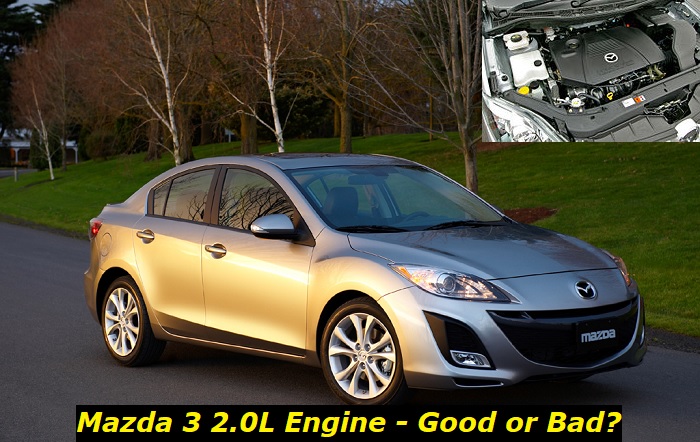The Mazda 3 is one of the legendary models that has always managed to find thousands of buyers and fans in all markets. Between 2010 and 2013, the second-generation Mazda 3 was sold in the US and it was one of the most successful generations with over 100,000 vehicles sold every year. This was the golden time for the model.
Today, we are going to talk about the 2-liter engine which was the base engine for the Mazda 3 in the American market and the most popular choice for buyers. So, we'll tell you everything you need to know to make up your mind. We love these vehicles, so some things may not be very unbiased today, but we'll try to keep it all as professional as possible.

Key features and my opinion about the engine
- Production years:2002-2015
- Average lifespan of MZR L-series:190,000-220,000 miles
- Fuel supply type:direct injection / port injection
- Power range:140-160 hp
- Fuel efficiency:average
- Engine block material:aluminum
- Engine reliability score:medium
- The most common problems:intake manifold flaps problems, throttle issues, thermostat and water pump failing, timing chain stretching, oil consumption, no lifters.
Some facts about the 2-liter Mazda 3 engine
We want to remind you that our key focus today is on the second-generation Mazda 3 equipped with the 2.0L non-turbo engine. So, what kind of engine is this? Actually, it's the L-series engine that was also used in Ford Focus and we perfectly know this engine thanks to this fact. Is it really good or bad? Hard to say, we should investigate deeper.
So, the Mazda MZR L-series 2-liter engine was installed under the hood of the Mazda 3 between 2010 and 2013. Also, you may want to know that this engine was used in the first-generation Mazda 3 and some other vehicles by this brand.
Here are some of the key facts about the powerplant:
- it offers decent power of 148 hp which is absolutely enough for the light body of the Mazda 3;
- with its torque of 135 lb-ft, the engine is certainly not made to tow trailers, but for daily driving, it's enough;
- the engine is praised for its fuel consumption - you can reach 33 mpg on highways and about 25 mpg in the city;
- the base model was equipped with the 5-speed manual transmission, but nearly all buyers preferred the good 5-speed automatic option;
- direct injection is something to remember - this is good for fuel economy but some problems come with this technology like carbon buildup on intake valves;
- the engine is not super dynamic or fast, it shows the maximum power at 6500 RPM and you aren't likely to rotate it to that point very often;
- the engine is pretty simple and lacks modern technologies which makes it reliable and predictable in terms of problems;
- the timing system is driven by a chain in this engine, this may sound like good news, but wait a bit before you decide anything.
Well, we don't know what else we should tell you about the construction and technologies of this engine. Ford installed the same engine under the name Duratec HE to its Focus up until 2007. And Focus drivers loved this engine. But for some reason, the same engine in Mazda got a lot of criticism.
Sometimes, we are just sure that the technologies used in a certain brand of vehicles are not as good as in other cars. And maybe this is the case with the Mazda 3. We still believe this is a cool option for young people who want some active driving. Yes, it won't allow you to speed up too fast but it gives some emotions for very little money.
What's the durability of the Mazda 3 2.0L engine?
We should be fair here, this is not the most durable engine Mazda ever made. It will last approximately 200,000 miles if maintained correctly. If not, it can fail even before the engine reaches 100K miles on its odometer. The main reason should be the oil quality because this engine relies on the proper oil and will not work well with low levels or poor quality engine lubrication materials.
We've still seen some Mazda 3 owners who managed to drive their cars more than 300,000 miles. For this, after the vehicle reaches 200K miles, you will need to have the engine repaired. Piston rings, rod bearings, and valve seals should be replaced as well as all gaskets. After this, the engine can go another hundred thousand miles unless it has a damaged block.
But if we were searching for a used 2010-2013 Mazda 3 with the 2-liter engine, we would definitely choose the option with up to 100,000 miles on it. Yes, you will overpay for it, but you will get a car whose condition is close to a new vehicle.
What are the main problems with the Mazda 3 2-liter engine?
We are talking about the engine that was installed in the 2010-2013 Mazda 3 (the second generation). And it has a lot of minor problems that you will have to deal with. For example, its direct injection system will cause some carbon buildup. But we don't consider this a major problem because now cleaning is not that expensive and this issue is common for all cars with direct-injection engines.
Instead, we'll talk about problems that are common for this Mazda 3 engine exclusively:
1. Timing chain problems
After 100,000 miles, the timing chain may stretch and start rattling. If you don't pay attention to this, the chain may jump. This will lead to a very unpleasant reunion of some valves with a piston inside the engine. After such an event, the valves will certainly be bent and the piston may also get a hole in it.
After timing chain jumping you will have to repair the engine or replace it. This will cost a lot of money and will take a lot of time. We recommend replacing the timing chain along with the water pump, tensioners, and all other parts that come in a kit approximately at 100,000 miles. This is expensive but far cheaper than repairing your engine.
2. High fuel consumption
Sometimes, this engine starts burning fuel like crazy. The ignition system and also fuel supply units may be in charge. First of all, check the injectors. They may be clogged or just not working because of their age. Also, spark plugs and ignition coils should be checked. If the engine misfires, it will burn a lot of fuel trying to compensate for the loss of power.
3. Unstable idling
If the RPM arrow starts dancing when the engine is idling, you should check the throttle. Very often, this unit gets clogged or broken. Again, this is all about the direct injection, but in Mazda 3 this happens too often.
Some owners just don't care about unstable RPMs when the vehicle is idling. But you should clean the throttle body or check the sensors that control it. Otherwise, after some time, the vehicle may just stall and lose power because of this issue.
4. Unadjusted valves
This engine is not equipped with any kind of lifters or other systems that can automatically adjust valves. Every 50,000 miles, you should have these valves adjusted. Otherwise, the engine will lose power, misfire, go to limp mode, stall, etc.
Valve adjustment is important but many owners forget about it when it comes to the maintenance of the Mazda 3. Put it in your plan and follow the recommended maintenance schedule to avoid the premature death of your engine.
5. Oil consumption
After 150,000 miles, this engine will inevitably start burning some oil. Piston rings and valve seals deteriorate and this leads to oil leaks inside the engine. The oil gets to the combustion chamber and burns together with fuel forming contamination in the engine head, exhaust valves, and also catalytic converter.
To avoid excessive oil consumption, you will have to replace the valve seals and piston rings, but it costs a fortune. So, usually, Mazda 3 owners just keep driving adding some oil to the engine now and then.
What should you do to avoid premature Mazda 3 engine death?
To prolong the life of your Mazda 3 MZR L-series engine, you should just follow the maintenance schedule and do everything you can to avoid common problems or deal with them as soon as possible.
These are the simple recommendations:
- change oil and all filters even more often than the manufacturer requires;
- listen to any unusual sounds of the engine and have it diagnosed if needed;
- don't forget about valve adjustment and also timing chain replacement;
- use only high-quality and clean fuel for your Mazda 3;
- don't experiment with parts quality when you repair or maintain the vehicle.
If you follow all of these recommendations, you can easily drive your Mazda 3 much longer than the stated 200,000 miles. Of course, it depends on your driving style. Mazda 3 2.0L engine doesn't like high RPM for a long time. Aggressive driving is certainly not good for this engine.
We love what the Mazda 3 2.0L engine gives you for the little money it costs. But of course, the vehicle still has a lot of problems to bear in mind.
About the authors
The CarAraC research team is composed of seasoned auto mechanics and automotive industry professionals, including individuals with advanced degrees and certifications in their field. Our team members boast prestigious credentials, reflecting their extensive knowledge and skills. These qualifications include: IMI: Institute of the Motor Industry, ASE-Certified Master Automobile Technicians; Coventry University, Graduate of MA in Automotive Journalism; Politecnico di Torino, Italy, MS Automotive Engineering; Ss. Cyril and Methodius University in Skopje, Mechanical University in Skopje; TOC Automotive College; DHA Suffa University, Department of Mechanical Engineering






Add comment